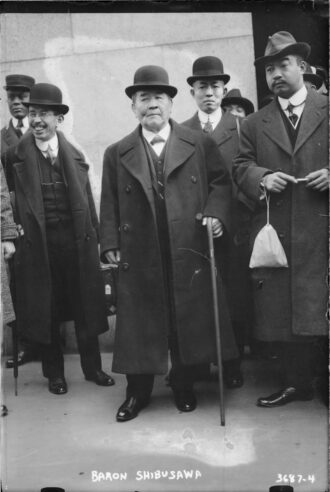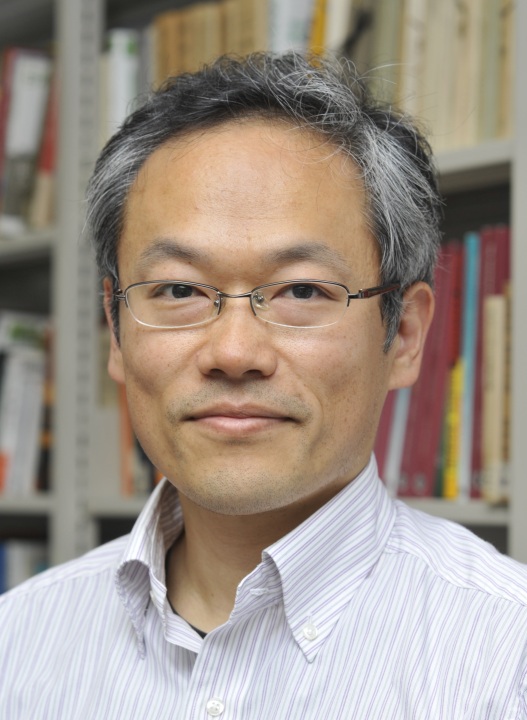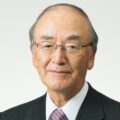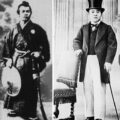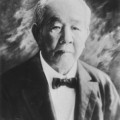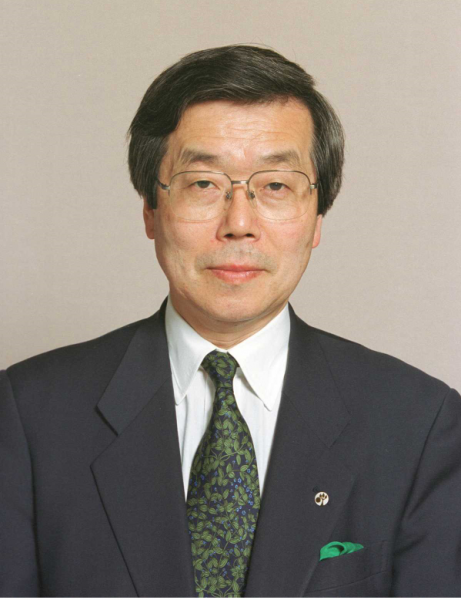Uniting the Minds of Merchants: Shibusawa Eiichi and the Tokyo Chamber of Commerce
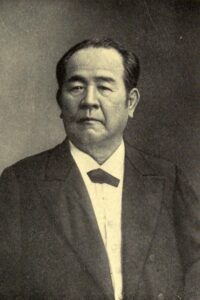
Known as the father of capitalism in modern Japan, Shibusawa Eiichi devoted his life to making economic circles more organized, as well as being involved in establishing nearly 500 companies. For twenty-seven years from 1878 to 1905, he served as the chairman of Tosho (Tokyo Shoho Kaigisho, the Tokyo Shoko-kai [Tokyo Chamber of Commerce] and currently the Tokyo Chamber of Commerce and Industry) and promoted a broad range of businesses.
Today, the Tokyo Chamber of Commerce and Industry (TCCI) undertakes a variety of activities as a private sector economic organization. Its forerunner, the Tokyo Chamber of Commerce (Tokyo Shoho Kaigisho), is closely linked to Shibusawa Eiichi, who was the first chairman and a central figure within the organization. Eiichi also chaired successive forms of the Tokyo Chamber of Commerce, namely the Tokyo Shokokai and the Tokyo Shogyo Kaigisho, and through his work was instrumental in “uniting the minds of merchants.”
Establishment of the Tokyo Chamber of Commerce
Chambers of commerce are economic and capitalist organizations established by merchants and industrialists in a given locale to express their intentions and protect their interests. The first such organization is said to have been founded in Marseille, France, in the sixteenth century. Since then, chambers have been established throughout Europe and around the world.
The first in Japan was the Tokyo Chamber of Commerce, founded in 1878 to provide a focal point for reaching a consensus among merchants on the revision of the unequal treaties.
Eiichi played a central role in the establishment of the Tokyo Chamber of Commerce and served as the chamber’s chairman for twenty-seven years, from its foundation until 1905. With a strong conviction that it was private business that should lead nation building centered on the capital city of Tokyo and holding fast to his ideals of the harmony of ethics and the economy and gappon capitalism, Eiichi led the Chamber’s activities from a global perspective.
In the early Meiji period (1868–1912), in the course of revising the unequal treaties signed with Western nations, the Japanese government realized the need for an organization to gather and represent the opinions of economic and industrial circles. For that reason, the then Minister of Finance, Okuma Shigenobu, recommended that merchants such as Shibusawa Eiichi, Masuda Takashi, Okura Kihachiro, and others operating predominantly in Tokyo, establish a chamber of commerce.
Eiichi and the others proceeded with preparations for establishing a chamber and, in December 1877, they submitted under joint signature a formal application for the establishment of a chamber of commerce. The Tokyo Chamber of Commerce was founded in March 1878, the first of its kind and without precedent anywhere in the country.
At the start there were fifty-one members. The first general meeting was held in August 1878 and elected Eiichi as chairman and Fukuchi Genichiro and Masuda Takashi as vice chairmen.
Private-Sector Diplomacy
As an organization that aimed to “unite the minds of merchants,” the Tokyo Chamber of Commerce undertook activities in numerous fields, including research and proposals related to economic policies, the arbitration of commercial disputes, recommendations related to treaty revisions, and private-sector diplomacy.
Ever since, private-sector diplomacy has been a major pillar of chamber of commerce activities in Tokyo.
As early as the beginning of the twentieth century, he was among the first people to foresee the United States’ potential for growth. On a trip to Europe and the United States, he deduced that a good relationship between Japan and the United States would be extremely important for peace in Asia, the Pacific region and the entire world.
From the opening of Japan in the mid-nineteenth century, trade and commerce with the United States expanded smoothly. The economic ties between the two countries became stronger after the Russo-Japanese War of 1904–5. Considerable friction was generated, too. Japanese business leaders wanted to have the Treaty of Commerce and Navigation between Japan and the United States amended as soon as possible so they could gain tariff autonomy and both countries could continue to expand their economic ties. They were concerned about the intensification of hostility between the two countries. This was when Komura Jutaro, the then Japanese foreign minister who concluded the Portsmouth Peace Treaty, invited Shibusawa Eiichi and other business leaders to his official residence and asked them to assist with the restoration of strong Japan-U.S. relations by strengthening bilateral friendships in private circles. This request came from the fact that public opinion had a significant influence on diplomatic policy in the United States. In other words, Komura was stressing the importance of private economic diplomacy.
The business leaders, including Eiichi, Nakano Buei (the second chairman of Tokyo Shoho Kaigisho), Doi Michio, Otani Kahei and Matsukata Kojiro began to explore what they could do as private organizations to help improve bilateral relations.
To develop a deeper understanding of the United States among the business leaders, an organization called the Commercial Commission’s Trip to the U.S.A. was formed by the leaders of chambers of commerce from the six major cities (Tokyo, Osaka, Kyoto, Kobe, Yokohama and Nagoya) and presidents of companies with close economic ties with the United States. Deciding on the head of the Commission was tremendously difficult until Eiichi was selected despite his advanced age of 69. For three months from 1 September to 30 November 1909, they visited major cities in the United States. They toured various places from a variety of perspectives, including political, economic, social, educational, cultural and religious ones, and interacted with prominent figures in various circles.
Another important purpose of the Commission was to explore the possibilities for peaceful competition and capital and technical cooperation in East Asia, especially the Chinese market, as well as developing bilateral friendship and commerce. Eiichi mentioned this often during his speech immediately prior to departure. The choice of destinations shows the Commission’s intention to develop the United States as a rising nation. The Commission included factories, department stores and other non-business related facilities as well as universities, welfare facilities and churches in its destinations in an effort to facilitate the domestic business leaders’ education on what was happening in other parts of the world. In other words, they aimed to encourage an understanding of international affairs and foreign countries and develop a healthy nationalism.
Activities of the Tokyo Chamber of Commerce
The other purpose of the Commission was to support reconstruction after the devastating Great Kanto Earthquake.
When the great earthquake struck the Kanto region on 1 September 1923, the Imperial Theatre adjacent to the Tokyo Chamber of Commerce burned down. However, the Tokyo Chamber of Commerce building was not damaged as the Imperial Theatre fire died down, and the Tokyo Chamber of Commerce began accepting evacuees on September 2 once the safety of the building was confirmed.
On September 9, approximately forty business leaders gathered. Shibusawa Eiichi, who served as the chairman despite being affected by the earthquake himself, proposed an organization for rescue and reconstruction consisting of civilian volunteers. On October 11, volunteers from the House of Peers and the House of Representatives also joined these business leaders and set up the Great Earthquake Zengokai (goodwill association), placing the headquarters in the Tokyo Chamber of Commerce. Thinking that prompt action distinctive of civilians and the careful attention of people from various fields who were pushed into the predicament were necessary, Eiichi conducted fund-raising activities for reconstruction and made efforts for rescue and recovery, using the network of the chambers of commerce in Japan and overseas.
Chamber Transitions
Following the promulgation of the Chamber of Commerce and Industry Act in 1927, the Tokyo Chamber of Commerce made the transition to the Tokyo Chamber of Commerce and Industry in 1928.
During the Second World War, the Tokyo Chamber of Commerce was reorganized into an organization called the Tokyo-to Shoko Keizai Kai as national policy. It came to be known in the present day as the Tokyo Chamber of Commerce and Industry through further reorganization after the war.
As a comprehensive regional economic group established for the purpose of contributing to the development of commerce and industry and the advancement of local communities, the Tokyo Chamber of Commerce and Industry makes various efforts, including the strengthening of corporate standings, environmental improvement, regional vitalization and community development.
The aspirations of Shibusawa Eiichi and others in establishing the Tokyo Shoho Kaigisho in the Meiji period has come down to the present day in a variety of ways.
Related article
Shibusawa Eiichi’s principle of “The Analects and the Abacus” will save the Japanese economy ― Hopefully, the will of the “father of Japanese capitalism” will be passed on in the new era
https://www.japanpolicyforum.jp/economy/pt20190711230502.html
Reprint from “Understanding Shibusawa (XXXVII): Uniting the Minds of Merchants: Shibusawa Eiichi and the Tokyo Chamber of Commerce and (XXXVIII): Shibusawa Eiichi and the Tokyo Chamber of Commerce,” The Japan Journal, October and November 2014. [July 2019]
Keywords
- Shibusawa Eiichi
- Eiichi Shibusawa
- Shibusawa Memorial Foundation
- Shibusawa Memorial Museum
- Tokyo Chamber of Commerce
- Tokyo Chamber of Commerce and Industry
- gappon capitalism
- Treaty of Commerce and Navigation between Japan and the United States
- Komura Jutaro
- Jutaro Komura
- Nakano Buei
- Buei Nakano
- Commercial Commission’s Trip to the U.S.A.
- Great Kanto Earthquake
